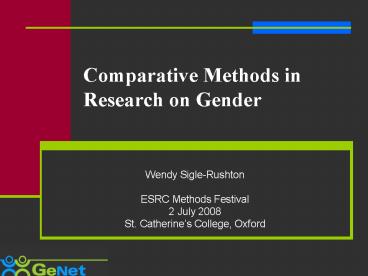Comparative Methods in Research on Gender - PowerPoint PPT Presentation
1 / 27
Title:
Comparative Methods in Research on Gender
Description:
Rake elderly, gender equality. Christopher (lone) mothers. Sainsbury gender equality ... Rake, K. (1999) Accumulated disadvantage? ... – PowerPoint PPT presentation
Number of Views:107
Avg rating:3.0/5.0
Title: Comparative Methods in Research on Gender
1
Comparative Methods in Research on Gender
- Wendy Sigle-Rushton
- ESRC Methods Festival
- 2 July 2008
- St. Catherines College, Oxford
2
Comparative Methods
- Why compare
- What to compare
- How to compare
- Benefits of comparison
- Caveats
3
Why compare
- Pragmatic concerns
- International agendas
- Broaden perspective
- Quasi-natural experiment
- Allows for theory building/testing
4
What to compare
- Comparisons across
- Countries
- Regions within countries (e.g. US States)
- Time
5
What to compare
- Variables to compare
- Inputs and Institutions
- Expenditure and welfare effort
- Aims and ideologies
- Politics
- Financing and delivery of policies
- Welfare mix
- Example Jane Lewis gender roles
6
What to compare
- Variables to compare
- Outcomes, for example
- Income distribution/poverty alleviation
- Social exclusion/inclusion
- Gender equality
- Decommodification
- Studies of outcomes
- Maitre et al income packaging
- Rake elderly, gender equality
- Christopher (lone) mothers
- Sainsbury gender equality
- Sigle-Rushton and Waldfogel earnings, household
income - Hobcraft and Sigle-Rushton social exclusion
7
How to compare
- Identify broad similarities and differences
- Exploit variation across space
- Simulations
8
Benefits of comparison
- Common and dissimilar problems/patterns
- Quasi-natural experiment
- Inspire best practice
- Inspire and inform good measurement
9
Caveats
- Reliance on similar, available measures
- Harmonisation
- Proxy variables
- Validity
10
Occupational Segregation, 2000
Source OECD 2002
11
Gender Wage Gap and Employment, 2000
Source OECD 2002
12
Caveats
- Reliance on similar, available measures
- Harmonisation
- Proxy variables
- Validity
- Tensions Difference and sameness
- Static measures
- Geographical variations often ignored
- Explanans et explanandum
- Requires a lot of detail
13
Example from my research on motherhood gaps in
earnings
- Data Luxembourg Income Study
- Strengths Harmonised data, large number of
countries - Relatively recent data available for many
countries - Countries
- Anglo-Saxon Canada, United Kingdom (UK), United
States - Continental Europe Germany, the Netherlands
- Nordic Norway, Sweden, Finland
14
Example from my research on motherhood gaps in
earnings
- Using the regressions
- Estimated wages for each age assuming different
fertility histories - Estimate motherhood gaps
- Estimate gender gaps by fertility history
15
Example from my research on motherhood gaps in
earnings
- Using the regressions
- What the regressions show
- Average gross earnings
- What they dont show
- The reasons for the differences
- Economic well-being
16
Example from my research on motherhood gaps in
earnings
- Overall patterns
- Large earnings penalties for each child, little
catch-up - Germany, Netherlands, UK (esp. first)
- Moderate earnings penalties for first child,
differences persist - Canada
- Small earnings penalty for each child, some
catch-up - US, Norway
- Moderate penalties for the first child, rapid
catch-up - Sweden, Finland
17
(No Transcript)
18
Example from my research on motherhood gaps in
earnings
- Overall patterns
- Large earnings penalties for each child, little
catch-up - Germany, Netherlands, UK (esp. first)
- Moderate earnings penalties for first child,
differences persist - Canada
19
(No Transcript)
20
Example from my research on motherhood gaps in
earnings
- Overall patterns
- Large earnings penalties for each child, little
catch-up - Germany, Netherlands, UK (esp. first)
- Moderate earnings penalties for first child, some
catch-up - Canada
- Small earnings penalty for each child, some
catch-up - US, Norway
21
(No Transcript)
22
Example from my research on motherhood gaps in
earnings
- Overall patterns
- Large earnings penalties for each child, little
catch-up - Germany, Netherlands, UK (esp. first)
- Moderate earnings penalties for first child, some
catch-up - Canada
- Small earnings penalty for each child, some
catch-up - US, Norway
- Moderate penalties for the first child, rapid
catch-up - Sweden, Finland
23
(No Transcript)
24
Cumulative earnings of mothers aged 18-45 with
medium education relative to non-mothers
Example from my research on motherhood gaps in
earnings
25
Example from my research on motherhood gaps in
earnings
Cumulative earnings of mothers aged 18-45 with
medium education relative to men
26
Summary
- Comparative studies can
- Highlight similarities and differences
- Inspire best practice
- But
- Direct of causation is rarely clear
- Explanatory processes are rarely clear
- Important measures may be omitted
- Individuals vary as well as policies
- Important to keep in mind when looking at
simulations - Predictive power is tentative
27
References
- Christopher, K. (2002) Helping mothers escape
poverty. LIS working paper No. 298. - Figari, F., Immervoll, H., Levy, H. and
Sutherland, H. (2007) "Inequalities within
Couples Market Incomes and the Role of Taxes and
Benefits in Europe". IZA Discussion Paper No.
3201 - Lewis, J. (1992) Gender and the Development of
Welfare Regimes, Journal of European Social
Policy 2(3)159-173. - Maitre, B., Nolan, B. and Whelan, C.T. (2005)
Welfare regimes and household income packaging
in the European Union. Journal of European
Social Policy 15(2) 157.171. - Rake, K. (1999) Accumulated disadvantage? Welfare
state provision and the incomes of older women
and men in Britain, France and Germany. In J.
Clasen (ed.) Comparative Social Policy Concepts,
Theories and Methods Oxford, Blackwell. - Sigle-Rushton, W. and Waldfogel, J. (2007)
Motherhood and womens earnings in
Anglo-American, Continental European, and Nordic
countries. Feminist Economics 13(2) 55-92.































